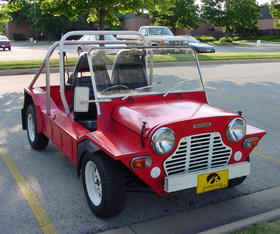Mini Moke
| Mini Moke | |
|---|---|
 |
|
| Overview | |
| Manufacturer |
BMC Leyland Australia British Leyland Portugal Cagiva |
| Also called | Austin Mini Moke Morris Mini Moke BMC Mini Moke (Military version) Leyland Moke (Australia) |
| Production | 1964–1993 |
| Assembly |
Vendas Novas, Portugal Setúbal, Portugal Longbridge plant, Birmingham, England Zetland, New South Wales, Australia Umtali, Rhodesia South Africa |
| Designer | Sir Alec Issigonis, John Sheppard |
| Body and chassis | |
| Class | utility vehicle |
| Body style | 4 seat convertible 2-seat pickup |
| Layout | FF layout |
| Powertrain | |
| Engine | 850 cc A-series, I4 998 cc I4 1098 cc I4 1275 cc I4 |
| Transmission | 4-speed manual |
| Dimensions | |
| Wheelbase | 2,020 mm (79.5 in) |
| Length | 3,050 mm (120.1 in) |
| Width | 1,300 mm (51.2 in) |
| Height | 1,400 mm (55.1 in)(with cloth roof and windshield raised) |
| Kerb weight | 406 kg (896 lb) — Early models 578 kg (1275 lb) — Later models |
The Mini Moke is a vehicle based on the Mini designed for the British Motor Corporation (BMC) by Sir Alec Issigonis and John Sheppard.
The name comes from "Mini"—the car with which the Moke shares many parts—and "Moke", which is an archaic dialect term for donkey. The Moke has been marketed under various names including Austin Mini Moke, Morris Mini Moke and Leyland Moke.
The initial design was a prototype for a light military vehicle in the style of the American Jeep, but its small wheels and low ground clearance made it impractical as an off-road vehicle. It was subsequently offered in a civilian version as a low-cost, easily maintained utility vehicle. The Moke finally achieved success as a beach buggy—becoming a popular "cult" vehicle in the Algarve, Seychelles, Australia, the United States and many tropical resorts in the Caribbean. The original Moke used identical engine, transmission and suspension parts from the Mini Van.
The first Mokes were only built at BMC's Longbridge, Birmingham plant. 14,518 Mokes were produced in the UK between 1964 and 1968, 26,000 in Australia between 1966 and 1981, and 10,000 in Portugal between 1980 and 1993 when production of the Moke ended.
When Issigonis designed the Mini, he planned another vehicle to share the Mini's mechanical parts, but with a more rugged body shell. This was an attempt to take a portion of the military vehicle business from Land Rover. Issigonis had previously designed the Nuffield Guppy in a failed attempt to break into that market. By 1959, BMC had working prototypes of what was codenamed "The Buckboard", later to become the Mini Moke. These prototypes were shown to the British Army as a parachute-droppable vehicle, but poor ground clearance and a low-powered engine did not meet the most basic requirements for an off-road vehicle. Only the Royal Navy showed any interest at all in the Buckboard—as a vehicle for use on the decks of aircraft carriers.
...
Wikipedia
